By LISA EISENHAUER
Jessica Verdugo credits the training and experience she got from the Community Health Worker Academy with opening her eyes to how seemingly minor barriers can keep people from accessing needed health care and to the many ways she can guide patients past
them.

Verdugo
"I didn't think that something as little as helping people make a phone call or helping them schedule an appointment would make a difference for them," says Verdugo, who graduated in February from the academy which is based at Charles R. Drew University of Medicine and Science in Los Angeles. She was one of 13 students in the certificate program's second class.
Since then, she's been working full time at clinics affiliated with Torrance Memorial Medical Center in the south Los Angeles suburb of Carson. The medical center and its clinics, part of the Cedars-Sinai system, provide care to many communities that
are economically challenged and have high concentrations of immigrants.
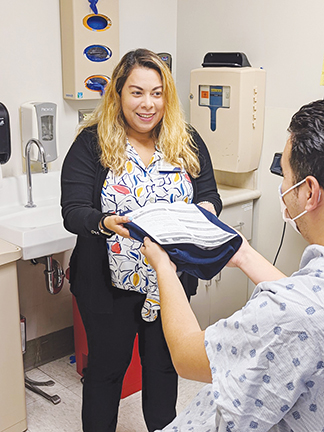
Micaela Reyes, a senior community health worker, hands a list of community resources and some new clothing to a patient in the emergency department at Providence Little Company of Mary Medical Center in Torrance, California. Reyes assists patients
who are experiencing homelessness in finding shelter and supportive services.
Verdugo lives in a community near Carson with similar demographics and she speaks fluent Spanish, the language of many of the patients she assists. "I think that's very important," she says. "A part of it is that they're comfortable with me and letting
me know what they need."
Verdugo's job includes helping patients follow through on referrals from primary care physicians to cardiologists, neurologists and other specialists. She helps schedule appointments for them and arranges transportation to the visits. She links expectant
and new mothers to prenatal and postnatal support groups.
New rule, new training
The Community Health Worker Academy is a collaboration between Providence St. Joseph Health and Charles R. Drew University of Medicine and Science, a private nonprofit school that has the federal designation
of Historically Black Graduate Institution. The academy's main goal is to train people as community health workers capable of assisting patients in clinical settings and in addressing social determinants that impact health outcomes.
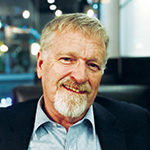
Tehan
Jim Tehan, senior director of community health investment for Providence Southern California, says the partnership launched in 2018. He explains that while Providence has employed community health workers for 20 years to reach underserved populations,
for the most part their work has been done outside of clinical settings and often in rural areas. It's a fairly new approach to put community health workers in clinics and hospitals in urban areas, he says.
The move to incorporate the workers into clinical settings in California got a boost in July from a rule change that allows care providers to get reimbursement for the services community health workers provide to patients enrolled in the state's Medicaid
program. That program, known as Medi-Cal, covers an estimated one-third of the state's population. The reimbursement required approval from the federal Centers for Medicare & Medicaid Services.
The list of conditions Medi-Cal says community health workers may address is long and includes the prevention and management
of chronic illness, mental health conditions including substance use disorders, reproductive health, environmental health, child health and development, oral health, aging and domestic violence.
CMS defines community health workers as "trusted members of their community who help address chronic conditions, preventive health care needs, and health-related social needs." The agency says the workers must demonstrate minimum qualifications through
one of several pathways, such as by completing a certification program.
Tehan says that because California had no statewide certification program for community health workers, Providence was interested in finding an academic partner to establish one.
"As we increased the use of community health workers in a variety of roles, it was like training every person every time, there was no formalized training," he explains. "It just seemed like kind of a smart idea to develop a pipeline."
Creating standards
Providence found the partner it needed in Charles R. Drew University, where Hector Balcazar, former dean of the College of Science and Health, and Sheba George, associate professor in the Department of Preventive
& Social Medicine, already were working on a curriculum for community health workers.
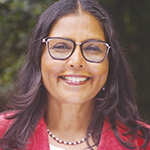
George
George says she and Balcazar thought standards needed to be developed for training for the workers and to establish a niche within the health care community to tap these workers' strengths, such as their understanding of the social determinants shaping
the health of their communities.
The program trains people to assume entry-level positions in health care. To enter the academy, students must be U.S. citizens who are at least 18 and have a high school diploma or its equivalency. Students do not need clinical experience, although it
is preferred.
The academy gives students five weeks of online classroom training to familiarize them with how hospitals and clinics operate and to teach them basic skills on how to link patients to medical and social support services. Then the students move to paid
internships at sites affiliated with one of several health care providers, including Providence and Dignity Health, which is part of the CommonSpirit Health system. The academy also provides ongoing technical assistance to the clinics and hospitals
to navigate challenges related to integrating community health workers into their teams.
Tehan says Providence finds the hospital and community clinic partners for the internships and also manages students' internship experiences at all of the sites, with particular attention to mentoring and coaching them while they are in the field.
Job security
Providence says the goal of the training program is "to create long-term job placements for community health workers in hospital and clinical settings." That is one of the reasons that a large chunk of the program's
initial funding came from the California governor's Office of Business and Economic Development. Other funders include Providence and the university.
Of the 28 students in the first two classes, 26 got offers of full-time positions, many from the providers where they did their internships.
The academy welcomed its third class this fall and Tehan reports that there is already talk of expanding enrollment. Providence is pursuing funding from foundations and Los Angeles County to bring interns to more sites, including some in the Los Angeles
city limits. Tehan says the plan is to continue to keep the class sizes to 15 or fewer and the length of the training at four months but to have two cohorts during each session.
"Many of these participants have not ever worked before," Tehan says. "As we get to populations that are more of our lived experience population (with little health care background), we feel like it's important to have that size where people feel like
not only are they learning from the training, but they're also learning from each other."
Peer to peer
Roland Hinds went through the classroom training in the Charles R. Drew academy at the suggestion of his supervisor even though he was already a community health worker based in the emergency room at Providence Holy
Cross Medical Center in Mission Hills. His primary role is to link people experiencing homelessness to shelter, mental health care, substance abuse treatment and other services.
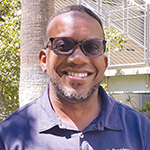
Hinds
When the academy's second cohort convened, Hinds went back as a lecturer, and he has joined the board that oversees the academy's curricula. He also mentors graduates. He says students have told him that they found the role-playing aspect of the training
that introduces real-world skills, such as how to interact with clinicians, as particularly helpful.
He says the academy has allowed hospitals and clinics to broaden the outreach of community health workers in suburban south Los Angeles County from the Latino community, where they have historical roots. The academy's graduates are from a range of ethnic
and cultural backgrounds as are the area's residents.
"I can't stress more that the diversity aspect of it is very important," Hinds says. "Who knows your neighborhoods better than the person who resides in the neighborhood?"
Easing the burden
Nazaret Núñez, the academy's program manager, is a former community health worker. She says community health workers face barriers in establishing a footing in clinical settings.
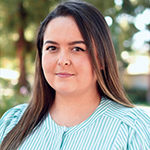
Núñez
"There's a lot of work in helping community health workers clarify to other team members and to patients what their role is and what it is that they bring that is different from other health care team members," she says.
As the daughter of Mexican immigrants, Núñez knows well that someone who can connect with patients based on culture and lived experience can be an invaluable guide to better health outcomes. She remembers as a teenager stepping in to help
as she saw how complicated it was for older members of her extended family to get treatment for chronic health conditions.
Núñez says that experience was not unique to her family or to her Latino community. She's aware that many Black and Asian households are just as befuddled by the hoops that they sometimes have to jump through to access health care and social
services.
"It makes me really happy to see community health workers entering clinical settings because, hopefully, now there's family members who can take a little bit more of a step back and find support in the clinic and in the hospital rather than trying to
navigate these additional barriers all by themselves," she says.
University tapped stakeholders, research in developing academy's curricula
The curricula for the Community Health Worker Academy at Charles R. Drew University of Medicine and Science incorporates the expertise of a variety of stakeholders and was guided by several resources, says Sheba George, associate professor in
the school's Department of Preventive & Social Medicine and one of those who helped craft the lesson plans.
The university tapped the knowledge and experience of community health work researchers, community health workers themselves, other health care professionals and students in drafting a training curriculum specifically for clinical settings, George
says.
In addition, the curriculum uses the standards and competencies established by a national group of experts known as the Community Health Worker Core Consensus Project or the C3 Project. That ongoing effort is led by a team of people in and outside the field who develop research-based resources to build cohesion, visibility and understanding of the role of community health workers, according to the group's
website. The site offers several downloadable guides and studies related to training community health workers and assessing their skills.
George and the others who developed Charles R. Drew university's curricula detailed their process in a paper published last year by
the journal Frontiers in Public Health.
The curriculum includes five weeks of classroom instruction that focus on:
- Establishing a professional community health worker identity and competencies.
- Outlining the context, process and key actors in health care settings with whom the workers will engage.
- Identifying the main forces that shape the health and health care outcomes of patients, families and communities.
The five-week classroom training is followed by an on-site paid internship at a hospital or clinic. In total, the training lasts four months.
— LISA EISENHAUER